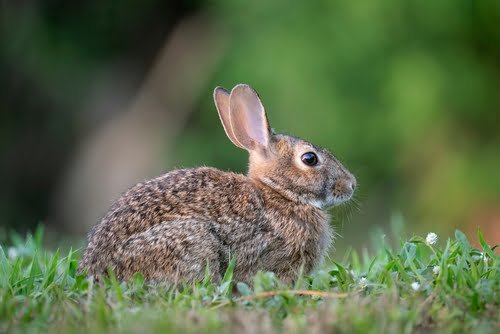The Best Rabbit Hunting Tips
Rabbit hunting is a cherished outdoor activity that has captivated hunters for generations. Beyond its popularity, rabbit hunting offers a thrilling and challenging experience, making it an engaging pursuit for beginners and seasoned hunters alike.
With its blend of strategy, patience, and marksmanship, rabbit hunting provides an opportunity to connect with nature while honing one’s skills in the field. In this blog, we will share our best rabbit hunting tips from experts across the East and West coasts.
Unlike some other game animals, rabbits have distinct behavioral patterns that must be comprehended to maximize the chances of a successful hunt. By gaining insight into their habits and habitats, hunters can effectively tailor their approach and increase their chances of spotting rabbits and successfully harvesting them.
Understanding Rabbit Behavior
Rabbits are known for being skittish creatures with remarkable agility and speed. Their acute senses allow them to detect even the slightest movement or sound in their surroundings.
Understanding these behaviors helps hunters anticipate their movements, enabling them to close the distance without alerting the quarry. Furthermore, knowledge of rabbit behavior aids hunters in predicting their feeding patterns and preferred areas of cover.
For instance, rabbits tend to frequent areas with dense vegetation or brushy cover where they can seek refuge from predators quickly. By recognizing these preferences, hunters can strategically position themselves for a higher chance of encountering rabbits during feeding times or when they venture out from hiding spots.
The Significance of Rabbit Habitat
Depending on the species, rabbits thrive in various environments across different regions—from dense forests to open meadows. Familiarizing oneself with regional rabbit habitat preferences is crucial for planning successful hunts under specific conditions.
For example, cottontail rabbits typically occupy brushy areas near field edges or hedgerows, while jackrabbits are often found in more open and arid landscapes. By understanding the nuances of rabbit habitats, hunters can choose appropriate hunting spots and adjust their strategies accordingly.
This knowledge allows hunters to make informed decisions about the gear, camouflage, and techniques they employ for a successful hunt. Whether hunting cottontails in dense cover or pursuing jackrabbits across vast plains, adapting to rabbits’ specific habitat requirements is key to becoming a skilled hunter.
Common Rabbit Species
Rabbits are small, furry mammals belonging to the family Leporidae. While numerous rabbit species exist worldwide, two common species found in North America are the cottontail rabbit and jackrabbit.
The cottontail rabbit is known for its short tail that resembles a cotton ball, while the jackrabbit has long ears and powerful hind legs. Both species have adapted to different habitats and exhibit distinct characteristics.
Cottontail rabbits (Sylvilagus spp.) are typically found in brushy areas and dense vegetation. They have a compact body structure, weighing around 1-3 pounds (0.5-1.4 kg), with short legs and strong hindquarters.
Cottontails possess excellent camouflage with brown or gray fur, allowing them to blend into their surroundings effectively. On the other hand, jackrabbits (Lepus spp.) are larger than cottontails, weighing between 3 and 7 pounds (1.4 and 3.2 kg).
Known for their long ears measuring up to 6 inches (15 cm), jackrabbits have powerful legs built for speed and agility. They primarily inhabit open grasslands and deserts, relying on their keen eyesight and hearing abilities to detect potential threats.
Insight into Rabbit Behavior
Understanding rabbit behavior is crucial for successful hunting endeavors. Rabbits are crepuscular animals, meaning they are most active during dawn and dusk when light conditions balance visibility and safety from predators.
During these periods, skilled hunters capitalize on low light conditions by strategically positioning themselves near likely cover where rabbits seek refuge. Feeding patterns also play a significant role in hunting rabbits effectively.
Rabbits primarily consume plant material such as grasses, leaves, bark, twigs, fruits, and vegetables, depending on availability within their habitat. Identifying food sources and common feeding areas such as meadows, clearings, or the edges of fields provides valuable information for hunters to focus their efforts.
Territorial instincts are another important aspect of rabbit behavior. Rabbits establish territories where they live, breed, and find shelter.
Understanding these territorial boundaries helps hunters identify areas where rabbits are likely to be present regularly. By observing rabbit behavior and territorial markings, such as scent glands and urine markings on logs or brush piles, experienced hunters can significantly increase their chances of spotting rabbits.
Importance of Studying Rabbit Tracks and Signs
Studying rabbit tracks and signs is fundamental for any serious rabbit hunter. Tracks left behind by rabbits can reveal valuable information about their presence in an area. Cottontails typically leave tracks with distinct oval-shaped imprints from their hind feet, while the front feet create smaller asymmetrical prints.
Jackrabbit tracks show elongated impressions due to their powerful hind legs. In addition to tracks, other signs like droppings (feces) and chewed vegetation provide further clues about rabbit activity.
Rabbit droppings are usually small pellets with rounded ends since rabbits have a unique digestive system that produces dry waste. Freshly gnawed twigs or branches suggest recent rabbit activity in the vicinity.
By studying these tracks and signs, experienced hunters can gain insights into the frequency of rabbit visits, preferred pathways, feeding areas, and potential hiding spots. This knowledge allows hunters to adjust their hunting strategies by focusing on areas with higher concentrations of fresh activity or identifying prime locations for setting up blinds or tree stands.
Understanding common rabbit species and their behavior patterns related to feeding and territorial instincts is crucial for successful hunting expeditions. By examining tracks and signs left behind by rabbits in their habitats, skilled hunters can gather valuable information that enhances their chances of locating these elusive creatures amid various environmental conditions.

Preparing for the Hunt
Choosing the right gear: firearms vs. archery equipment
When selecting the appropriate gear for rabbit hunting, one of the first decisions is whether to use firearms or archery equipment. Both options have advantages and ultimately depend on personal preference and local regulations. Firearms provide a higher range and accuracy, making them ideal for long-distance shots or hunting in open fields.
Shotguns loaded with small game loads or .22 caliber rifles are popular choices among hunters due to their effectiveness in taking down rabbits swiftly. On the other hand, archery equipment can offer a more challenging and rewarding experience, requiring greater patience and precision in aiming. Bows equipped with broadhead arrows designed specifically for small game hunting ensure ethical kills while adding an extra element of skill to your pursuit.
Selecting appropriate clothing and footwear for comfort and camouflage
To maximize your chances of success while remaining comfortable in the field, it is crucial to choose appropriate clothing and footwear. Opting for earth-toned or camouflage patterns that blend well with the natural surroundings will make you less visible to rabbits’ keen eyesight. Lightweight but durable pants, preferably with reinforced knee sections, can protect against thorny bushes or sharp rocks often encountered while navigating brushy areas.
Additionally, wearing layers allows you to adjust your clothing according to weather conditions throughout the day, ensuring optimal comfort even during temperature fluctuations. Regarding footwear selection, consider boots that provide ankle support while being comfortable enough for long walks or extended periods of stalking prey.
Insulated waterproof boots are particularly beneficial during colder months when wet environments can be expected. They mustn’t emit loud sounds while walking, as rabbits have acute hearing capabilities that could detect your approach.
Overview of essential hunting accessories (binoculars, game calls, etc.)
In addition to the right gear and clothing, certain hunting accessories can greatly enhance your rabbit hunting experience. A quality pair of binoculars is essential for scouting potential habitat areas from a distance and spotting rabbits in their natural environment. Look for binoculars that offer a wide field of view and good low-light performance to ensure clear vision, even during early morning or late afternoon hunts.
Game calls can be highly effective in attracting rabbits by mimicking their vocalizations and piquing their curiosity. Electronic predator calls or mouth-operated cottontail distress calls are commonly used to lure rabbits out of hiding.
These tools require practice to produce realistic sounds, so familiarize yourself with proper techniques beforehand. Other helpful accessories include a small game bag or vest to carry harvested rabbits, a knife for field dressing, and a first-aid kit for unexpected injuries.
Additionally, having a map of the hunting area and a compass can assist in navigation throughout unfamiliar terrain. By carefully selecting the right gear, clothing, and accessories tailored to your hunting style and environmental conditions, you’ll be well-prepared to embark on successful rabbit hunts while ensuring your comfort and safety in the great outdoors.
Scouting Rabbit Habitats
Identifying Preferred Habitats
When it comes to rabbit hunting, understanding the preferred habitats of these elusive creatures is crucial for success. Rabbits are commonly found in brushy areas, hedgerows, and fields with ample cover. Brushy areas provide rabbits with both shelter and a variety of forage options.
Hedgerows, with their dense vegetation and interconnected branches, offer rabbits protective cover against predators while providing them easy access to adjacent feeding grounds. Fields with cover, such as tall grasses or crops like clover or alfalfa, are also attractive to rabbits as they provide abundant food sources along with concealment from potential threats.
Tips on Locating Prime Spots
To locate prime rabbit hunting spots before heading into the field, utilizing topographic maps or aerial imagery can greatly enhance your chances of success. By studying these resources, you can identify suitable areas that meet the above criteria – brushy areas, hedgerows, or fields with cover – within your chosen hunting location. Please pay attention to terrain features like gullies and low-lying areas near water sources, as they often provide favorable conditions for rabbits.
While maps give you a general idea about potential habitats, nothing beats firsthand observation. Before your hunting day, it is advisable to scout the area by spending time observing rabbit activity in different locations.
Look for signs such as burrows at the bases of shrubs or small trees and trails leading into dense vegetation. Note where tracks are concentrated or droppings accumulate abundantly; these indicate high-traffic areas that rabbits frequent.
Observing Rabbits’ Preferred Feeding Areas
One of the keys to successful rabbit hunting is understanding their feeding patterns and locating their preferred feeding areas. Rabbits are predominantly herbivores and prefer young succulent plants, grasses, and clover.
While they browse vegetation within their home range, certain areas might be particularly attractive due to abundant food sources. To increase your chances of success, observe rabbits’ feeding behavior in the field.
Early mornings and evenings are ideal, as rabbits are more active during these periods. Look for areas with low-lying vegetation or open patches amidst dense cover where rabbits can easily access their preferred food sources.
Taking note of these feeding areas will allow you to plan your hunting strategy accordingly, increasing the likelihood of encountering rabbits during your hunt. Remember, scouting rabbit habitats is an ongoing process that requires patience and observation skills.
By identifying preferred habitats such as brushy areas, hedgerows, and fields with cover, utilizing maps to locate prime spots, and observing rabbits’ feeding patterns in the field, you can significantly improve your chances as a seasoned rabbit hunter.
Hunting Techniques
Stalking: Tips on Moving Quietly through the Terrain to Avoid Alerting Rabbits
Stalking is a skill that requires patience, agility, and careful observation. When engaging in this technique, it is crucial to move silently through the terrain to avoid alerting rabbits and giving away your presence.
Start by wearing lightweight and quiet clothing that won’t rustle or make unnecessary noise. Take slow and deliberate steps, placing your feet gently on the ground to minimize any sound created by crunching leaves or twigs.
Walking heel-to-toe can help distribute your weight more evenly and reduce noise. To approach rabbits undetected, utilize natural cover such as bushes, trees, or rocks.
These elements can provide both visual concealment and noise reduction. Move slowly from one cover spot to another, pausing frequently to scan for movement or signs of rabbit activity.
When crossing open areas without cover, crouch low or crawl stealthily while looking for potential hiding spots where rabbits might be lurking. Additionally, spotting rabbits before they spot you is key in stalking.
Train yourself to look for subtle movements or signs of rabbit presence, such as twitching ears or a flash of white tail. Keep your eyes sharp and focus on the area ahead rather than just looking directly in front of you.
Driving: Explanation of Techniques Involving Multiple Hunters
Driving is a highly effective technique when hunting rabbits in groups. It involves strategically moving through rabbit habitats to flush them out from their hiding places towards waiting hunters who are strategically positioned around potential escape routes.
To execute a successful drive, hunters need to coordinate their movements effectively. Establish clear communication signals between each group member using hand signals or prearranged calls so everyone knows when to start moving forward together.
When driving rabbits from cover, it’s essential to move slowly and evenly. Rushing or making sudden movements can cause the rabbits to scatter in different directions, reducing the chances of a successful harvest.
As you advance, stay in a line formation with other hunters, maintaining equal spacing between each person. To effectively flush out rabbits, it’s crucial to coordinate movements and direct the rabbits toward designated shooters.
This can be achieved by strategically placing hunters at potential escape routes or openings where rabbits are likely to flee. By positioning shooters effectively during a drive, they can capitalize on the opportunity presented when rabbits emerge from cover.
Tactics for Positioning Shooters Effectively During a Drive
When positioning shooters during a drive, various factors need consideration for optimal success. Firstly, identify key escape routes or openings that rabbits might utilize to evade the advancing hunters. These include open fields, hedgerow gaps, or well-traveled trails through brushy areas.
Next, place experienced shooters at strategic locations along these escape routes. Position them slightly apart but within sight so they can coordinate their shots if needed.
Shooters need to have good visibility of both the approaching hunters and potential rabbit escape paths. Additionally, consider wind direction when positioning shooters as it affects how scent is carried and may alert rabbits before they reach shooting range.
Place shooters downwind from where you expect the rabbit movement so their scent won’t reach the approaching rabbits and deter them prematurely. Ensure that all participating hunters are familiar with safety regulations and maintain clear lines of sight between themselves while avoiding any unsafe crossfire situations.
Communication among the group is vital during drives to prevent accidents and ensure everyone’s safety throughout the hunt. Remember that whether you choose stalking or driving techniques while rabbit hunting, practice makes perfect.
As experienced hunters know all too well, understanding how to hunt rabbits in different conditions is invaluable knowledge gained through years of experience combined with a deep understanding of rabbit behavior and habitat. So, go out there, sharpen your skills, and enjoy the thrill of the hunt with these Rabbit Hunting Tips for Experienced Hunters.
Ethical Considerations & Safety Measures
Importance of practicing ethical hunting by following local regulations
When engaging in rabbit or any other form of hunting, it is of utmost importance to adhere to the local regulations and guidelines set forth by wildlife management authorities. These regulations ensure the sustainable conservation of rabbit populations and the overall ecosystem. By respecting these rules, hunters contribute to preserving wildlife and their habitats.
It is crucial to familiarize oneself with specific hunting seasons, bag limits, and restricted areas where hunting may not be permitted. Additionally, understanding the laws regarding firearm usage and obtaining necessary permits or licenses is essential to maintaining ethical practices while pursuing this beloved outdoor activity.
Safety precautions when handling firearms or archery equipment in a group setting
Hunting rabbits often involves group outings where safety becomes paramount. Whether using firearms or archery equipment, hunters must prioritize safety measures at all times.
Proper handling of weapons should be ingrained through training and experience. Always assume that a firearm or bow is loaded until confirmed otherwise.
Careless action can lead to severe consequences; thus, following basic firearm safety rules should be second nature: keep fingers off triggers until ready to fire, never point a weapon at anything other than your target, and be aware of your surroundings at all times. In group settings, clear communication among hunters becomes imperative for safe coordination during rabbit drives or stalking hunts.
Establishing safe zones where participants are positioned strategically ensures that everyone’s line of fire remains directed away from each other’s positions. Wearing highly visible clothing or employing blaze orange gear further reduces risks by enhancing visibility among fellow hunters.
Respecting wildlife
While rabbit hunting can provide enjoyable pursuits for outdoorsmen and women who appreciate the thrill of the hunt, it is equally important to respect wildlife throughout this endeavor. Practicing ethical hunting involves not just following regulations but also showing respect and reverence towards the animals being pursued. This includes minimizing unnecessary suffering by aiming for ethical shots that produce quick, humane kills.
Additionally, hunters should strive to leave minimal environmental impact by properly disposing of waste and respecting private property boundaries. Respecting wildlife also extends beyond the act of hunting itself.
Learning about rabbit behavior, their role in the ecosystem and contributing to conservation efforts will foster a deeper appreciation for these creatures and their habitats. By actively engaging in conservation initiatives and supporting organizations dedicated to protecting wildlife, hunters can contribute positively to preserving this natural heritage for generations.
Conclusion
Rabbit hunting is an age-old pursuit that requires not only skill but also a commitment to ethical considerations and safety measures. By adhering to local regulations, practicing safe handling of firearms or archery equipment in group settings, and showing respect towards both the animals being hunted and the environment they inhabit, hunters can engage in this activity responsibly.
Remembering that our actions as hunters have a direct impact on wildlife conservation will help ensure that future generations can continue enjoying the thrill of pursuing rabbits while fostering a sustainable balance between human activities and nature’s delicate ecosystem. So embrace these rabbit hunting tips for experienced hunters with enthusiasm and responsibility – happy hunting!






